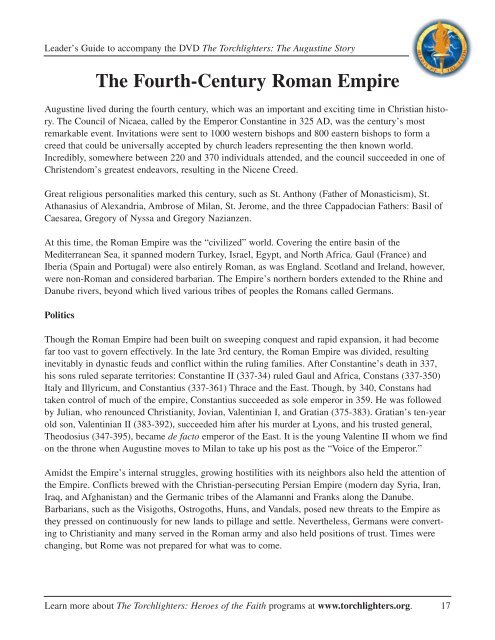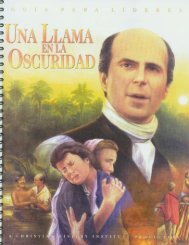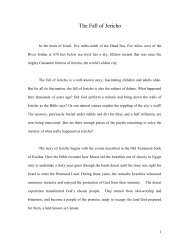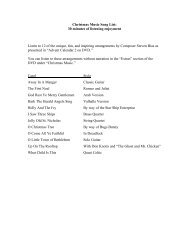Torchlighters: Augustine Leader's Guide - Vision Video
Torchlighters: Augustine Leader's Guide - Vision Video
Torchlighters: Augustine Leader's Guide - Vision Video
Create successful ePaper yourself
Turn your PDF publications into a flip-book with our unique Google optimized e-Paper software.
Leader’s <strong>Guide</strong> to accompany the DVD The <strong>Torchlighters</strong>: The <strong>Augustine</strong> StoryThe Fourth-Century Roman Empire<strong>Augustine</strong> lived during the fourth century, which was an important and exciting time in Christian history.The Council of Nicaea, called by the Emperor Constantine in 325 AD, was the century’s mostremarkable event. Invitations were sent to 1000 western bishops and 800 eastern bishops to form acreed that could be universally accepted by church leaders representing the then known world.Incredibly, somewhere between 220 and 370 individuals attended, and the council succeeded in one ofChristendom’s greatest endeavors, resulting in the Nicene Creed.Great religious personalities marked this century, such as St. Anthony (Father of Monasticism), St.Athanasius of Alexandria, Ambrose of Milan, St. Jerome, and the three Cappadocian Fathers: Basil ofCaesarea, Gregory of Nyssa and Gregory Nazianzen.At this time, the Roman Empire was the “civilized” world. Covering the entire basin of theMediterranean Sea, it spanned modern Turkey, Israel, Egypt, and North Africa. Gaul (France) andIberia (Spain and Portugal) were also entirely Roman, as was England. Scotland and Ireland, however,were non-Roman and considered barbarian. The Empire’s northern borders extended to the Rhine andDanube rivers, beyond which lived various tribes of peoples the Romans called Germans.PoliticsThough the Roman Empire had been built on sweeping conquest and rapid expansion, it had becomefar too vast to govern effectively. In the late 3rd century, the Roman Empire was divided, resultinginevitably in dynastic feuds and conflict within the ruling families. After Constantine’s death in 337,his sons ruled separate territories: Constantine II (337-34) ruled Gaul and Africa, Constans (337-350)Italy and Illyricum, and Constantius (337-361) Thrace and the East. Though, by 340, Constans hadtaken control of much of the empire, Constantius succeeded as sole emperor in 359. He was followedby Julian, who renounced Christianity, Jovian, Valentinian I, and Gratian (375-383). Gratian’s ten-yearold son, Valentinian II (383-392), succeeded him after his murder at Lyons, and his trusted general,Theodosius (347-395), became de facto emperor of the East. It is the young Valentine II whom we findon the throne when <strong>Augustine</strong> moves to Milan to take up his post as the “Voice of the Emperor.”Amidst the Empire’s internal struggles, growing hostilities with its neighbors also held the attention ofthe Empire. Conflicts brewed with the Christian-persecuting Persian Empire (modern day Syria, Iran,Iraq, and Afghanistan) and the Germanic tribes of the Alamanni and Franks along the Danube.Barbarians, such as the Visigoths, Ostrogoths, Huns, and Vandals, posed new threats to the Empire asthey pressed on continuously for new lands to pillage and settle. Nevertheless, Germans were convertingto Christianity and many served in the Roman army and also held positions of trust. Times werechanging, but Rome was not prepared for what was to come.Learn more about The <strong>Torchlighters</strong>: Heroes of the Faith programs at www.torchlighters.org. 17







